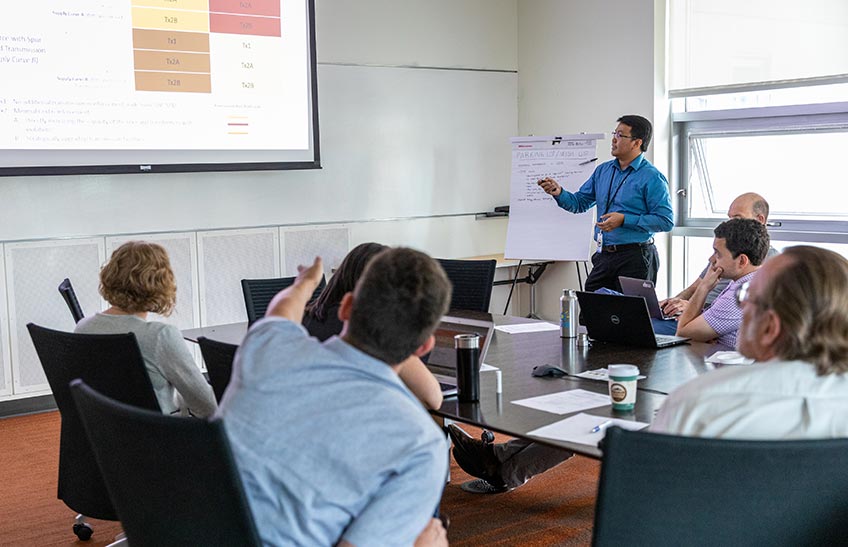Research Exchange at NREL Accelerates Philippines' Clean Energy Transition
Philippines' Modeling Group Works with NREL Experts to Enhance Transmission System Planning

Hanzel Cubangbang presents details about the transmission planning model to a group of NREL and USAID team members. Photo by Werner Slocum, NREL
The United States Agency of International Development (USAID) and NREL Partnership hosted a modeling group from the Philippines at NREL's campus for a month-long research exchange supporting the Philippines' development of competitive renewable energy zones (CREZ). By working directly with NREL's power sector experts, the group refined key models used to enable proactive transmission planning for scaling up renewable energy in the Philippines.
A CREZ is a geographic area with high-quality variable renewable energy resources (such as wind and solar), suitable topography and land-use designations for development, and demonstrated interest from project developers.
The CREZ transmission planning process helps to plan, approve, and build transmission infrastructure to connect CREZs to load—supporting reliable and economic integration of renewable energy.
The CREZ process was formalized in 2018 by the Philippines Department of Energy (PDOE) and helps solve a common circular dilemma between financing renewable energy projects and their transmission development. Financing is not accessible to renewable energy developers in regions without transmission; however, new transmission systems cannot be approved by regulators without establishing the need for additional generation.
Cubangbang, who is the Principal Engineer of Grid Securities at the National Grid Corporation of the Philippines (NGCP), which operates, maintains, and develops the country’s transmission system, described how the Philippines' CREZ process addresses this dilemma. "Projects were coming in, but transmission was not ready for them. The CREZ process solves that challenge because we determine the best area for developers to connect, and already have transmission facilities ready for them."
Text Version
Renewable Energy Zone Toolkit in Action
The PDOE worked with the USAID-NREL Partnership to conduct a first-of-its-kind CREZ process utilizing the approach detailed in the Renewable Energy Zone Toolkit and Renewable Energy Zone Transmission Planning Process Guidebook. This process engaged a broad set of stakeholders through a technical advisory committee and two multi-agency working groups. After identifying an initial set of CREZs, five representatives from PDOE and NGCP came to NREL to take part in daily seminars, NREL-expert advisory meetings, and working sessions focused on:
- Improving their capacity expansion and production cost modeling capabilities.
- Developing a set of transmission development plans to deliver power from CREZs throughout the Philippines.
The capacity expansion model determines what generation should be built to reliably and cost-effectively meet demand through 2040.
The production cost model analyzes various renewable energy and transmission scenarios to optimize hourly generator output, resulting in the lowest cost, and stable operation of the power system.
The two models estimate the costs, benefits and impacts of each transmission enhancement option. Together, they help the PDOE and NGCP understand how the power system would operate under different CREZ transmission scenarios.
Returning Home with Results
The working group returned to the Philippines armed with upgraded models, stronger modeling capabilities, and the capacity to independently move forward supporting the country’s transmission planning and development to meet their renewable energy goals.
"This research exchange improves our own decision making and allows us to know more overall about modeling dynamics as we integrate these resources," said Noriel Reyes, senior science research specialist of the PDOE.
Previously, team members from USAID, NREL and the Philippines produced the Greening the Grid: Solar and Wind Integration Study. The study confirms it is feasible to achieve 30-50% renewable energy penetration in the Philippines by 2040. The current CREZ study furthers this collaborative research.
"The solar and wind integration study answered the question of if we can take in 30-50% renewable energy by 2040," said Reyes. "Now, renewable energy zones address how we go about tapping the resources that are very much available in those identified areas."
Looking Forward to a Clean Energy Future
Both Reyes and Cubangbang agree the time at NREL expanded their team's perspective on possibilities for the Philippines' clean energy transition.
"We're not confining ourselves to this study. While at NREL, we accessed many experts to understand what else might be helpful when implementing projects to reach beyond our 30-50% goal," said Cubangbang. "The more we learn about the Philippines and our power, the more we can launch studies together with USAID-NREL and enable more renewable energy in the Philippines."
Harnessing these indigenous renewable energy resources will contribute to the government of the Philippines’ vision to ensure sustainable, secure, sufficient, accessible, and affordable energy. The government prioritized renewable energy development in 2008 with the Renewable Energy Act as a means to increase energy self-sufficiency and serve their population's growing energy demands.
"It is already there," Reyes added. "Renewable energy is present. It is available. It is just a matter of tapping into it to power our systems."
Last Updated May 28, 2025
